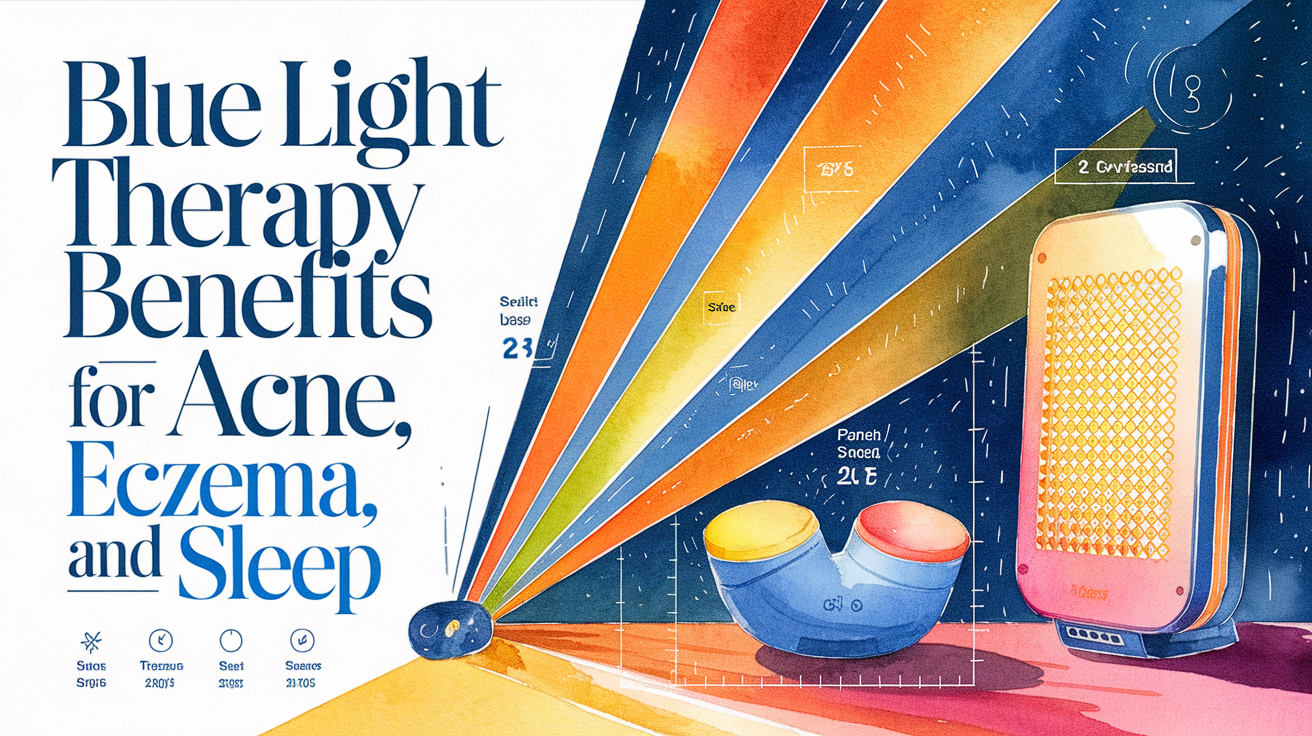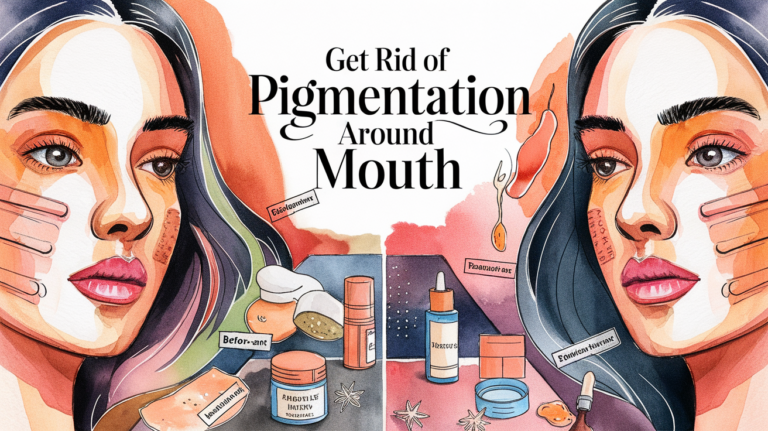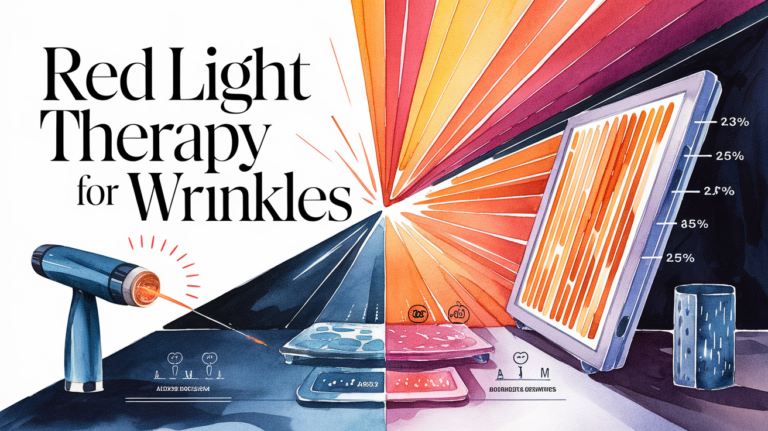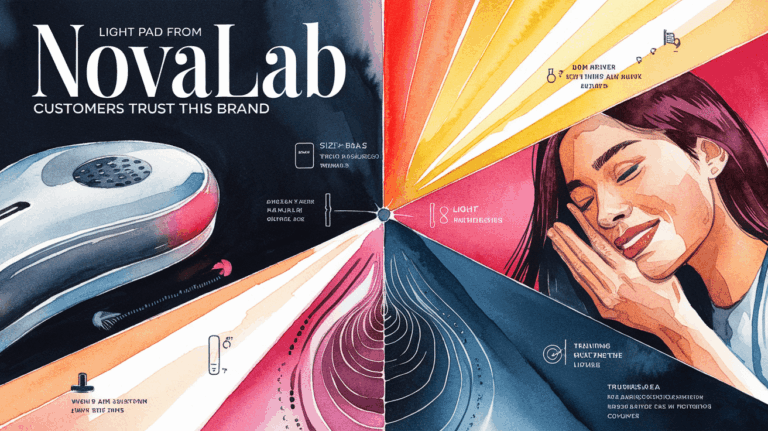7+ Blue Light Therapy Benefits for Acne, Eczema and Sleep

Begin Your Wellness Journey with Blue Light Therapy
Blue light therapy offers many wellness benefits you can enjoy from home. It can help reduce acne, ease eczema, fade acne scars, and even treat precancerous conditions like keratosis.
Beyond skin health, blue light can also support your mental well-being. By helping to manage melatonin production, it can also assist with seasonal affective disorder (SAD).
This non-invasive and effective therapy is a natural way to enhance your self-care routine. It addresses a wide range of concerns, from acne and wrinkles to insomnia and the winter blues.
Supported by numerous studies, blue light therapy is a versatile option for self-care. It’s available without a prescription, making it an accessible way to support your health.
How Blue Light Fights Acne for a Clearer Complexion
Blue light therapy is known for being effective against acne. It works by targeting the bacteria that cause breakouts.
This therapy specifically targets Propionibacterium acnes, the bacteria responsible for most acne. Exposure to blue light causes these bacteria to self-destruct, which helps reduce future acne breakouts.
With the bacteria eliminated, inflammation, redness, and blemishes can begin to fade. This approach leads to visible improvements in your skin’s clarity, tone, and texture.
Numerous studies confirm that blue light can reduce acne by up to 80%. It is a valuable part of any acne treatment plan, especially for those with antibiotic resistance or sensitivity.
Table: Studies on the Effects of Blue Light in Reducing Acne
| Study | Light Source | Treatment Protocol | Number of Subjects | Outcome |
| Kawada et al., 2002 | 407–420 nm halide lamp | Treatments twice a week for 5 weeks | 30 | 77% of patients showed improvement |
| Noborio et al., 2007 | 405–420 nm intense light | On average 12.4 treatments once a week | 10 | 80% of patients showed improvement |
| Ammad et al., 2008 | 415–425 nm intense light | Two treatments a week for 4 weeks | 21 | Significant improvement in the Leeds Acne Grade and both inflammatory and noninflammatory lesion counts |
| Omi et al., 2004 | 420 nm intense light | Eight serial biweekly treatment sessions | 28 | 64.7% improvement in acne lesions |
| Wheeland and Dhawan, 2011 | 410 nm LED | Twice daily for eight weeks | 28 | More than 90% of subjects reported improvements in their skin’s overall appearance, clarity, radiance, tone, texture, and smoothness by week 8 |
| Gold et al., 2009 | 414 nm LED | Blue light applied once daily for six minutes for eight weeks | 21 | Significant reduction in the total number of comedones on the face by day 7 and day 28 |
| Morton et al., 2005 | 409–419 nm LED | Eight 10- or 20-min light treatments at 40 W/cm2 over 4 weeks | 30 | The overall effect on inflammatory counts was observed at week 5 and a statistically significant decrease in inflamed counts was detected at the week 8 assessments, which continued to week 12 |
You can learn more about these studies and others in the comprehensive review “Blue light for infectious diseases: Propionibacterium acnes, Helicobacter pylori, and beyond?“
Can Blue Light Help Reduce the Appearance of Scars?
Blue light therapy can also visibly improve the appearance of acne scars. It works by stimulating your skin’s own natural healing processes from deep within.
Often paired with red and infrared light, blue light encourages the production of collagen and elastin. These essential proteins are the building blocks of healthy, supple skin.
This therapy also speeds up cell turnover. This helps your body replace damaged skin with new, healthy cells more quickly.
By reducing redness and inflammation, blue light helps calm the skin, which is crucial for effective healing. These actions work together to diminish the depth and color of scars. In fact, studies found that treating skin with blue light actually helps prevent scarring from forming in the first place.
Soothe Your Skin with Gentle Relief for Psoriasis and Eczema
Blue light therapy can provide significant relief for those suffering from skin conditions like psoriasis and eczema. It offers a gentle way to manage persistent symptoms.
The therapy helps to reduce the itchiness, redness, and inflammation associated with these uncomfortable conditions. While not a cure, consistent treatment sessions can help manage symptoms and improve the skin’s overall appearance.
Blue light is considered a safer alternative to traditional ultraviolet (UV) light therapy. One study on eczema patients showed a significant symptom reduction in all subjects, and three participants even experienced 100% remission.
Another study comparing light therapies for the reduction of psoriasis found that blue light was highly effective. It performed as well as red light in reducing scaling and redness, and it was superior in reducing skin plaques.
Can Blue Light Soften Fine Lines and Wrinkles?
Blue light therapy may help reduce the appearance of wrinkles by rejuvenating the skin from within. It stimulates the production of collagen and elastin, which are essential proteins for firm skin.
This process helps improve skin elasticity, making it more resilient and youthful-looking. The therapy also encourages healthy cell turnover, refreshing the surface of your skin.
By promoting these natural functions, blue light helps to reduce the visible signs of aging. A study of red light on wrinkle reduction demonstrated its effectiveness, where 100% of participants saw a significant reduction in symptoms.
Those subjects used a light therapy face mask just twice a week for three months. The study noted that wrinkle reduction continued throughout the entire period, which suggests lasting benefits.
How Is Blue Light Used to Treat Actinic Keratosis?
Actinic keratosis (AK) is a skin condition that is considered precancerous. It often appears as small, rough, or scaly patches on sun-exposed areas of the skin.
Blue light therapy is an effective, non-invasive treatment for AK. The treatment works by using a photosensitizing agent applied to the skin.
This agent makes the affected cells highly sensitive to light. When blue light is applied to the area, it activates the agent, causing a chemical reaction that destroys the precancerous cells.
This targeted approach minimizes damage to the surrounding healthy tissue. The process is safe, well-tolerated, and an important treatment for preventing potential skin cancer.
Brighten Your Mood: A Natural Remedy for Seasonal Affective Disorder (SAD)
Blue light therapy is also beneficial for individuals affected by Seasonal Affective Disorder (SAD). This condition is a type of depression that usually occurs during the winter months when natural sunlight is limited.
Research shows that exposure to blue light can ease the symptoms of SAD. It works by improving mood and boosting energy levels, helping you feel more like yourself again.
Traditionally, doctors treat SAD with 10,000-lux white light, known as bright light therapy. However, researchers discovered that adding blue light to the therapy makes it much more efficient.
With blue light included, the necessary intensity can be reduced from 10,000 lux to just 750 lux. Despite the lower intensity, it achieves the same positive results by helping reset the body’s internal clock and reducing depressive symptoms.
How to Improve Sleep with Blue Light Therapy
Your circadian rhythm is your body’s internal 24-hour clock that tells you when to sleep and wake up. Exposure to blue light plays a key role in keeping this clock on schedule.
Exposure to blue light, particularly in the morning, signals your body to reduce the production of melatonin, the hormone that makes you feel sleepy. This tells your body that it’s time to be awake and alert.
A study testing blue light exposure for two hours before 9:00 am found that it helped subjects fall asleep faster later that night.
The timing of your blue light exposure is crucial. In contrast, another study on removing blue light at night showed that wearing blue-blocking glasses for two hours before bed helps you fall asleep faster.
This therapy is also beneficial for broader sleep disorders. A randomized clinical trial found that timed light therapy improved multiple sleep metrics in patients with Parkinson’s disease and daytime sleepiness.
By exposing individuals to timed blue light, this therapy effectively synchronizes the body’s internal clock and helps regulate sleep patterns. This makes it a valuable tool for anyone looking to improve their sleep quality.
What’s the Science Behind Blue Light Wavelengths?
Blue light has a specific place on the electromagnetic spectrum, right next to ultraviolet (UV) light. Its short wavelengths give it unique properties.
While UV light can be harmful, blue light within the therapeutic range is safe and beneficial for home use. Therapeutic blue light typically operates within the 400 to 500 nanometer (nm) wavelength range.
Different wavelengths within this range have unique effects on the body. For example, research has identified that 420 nanometer (nm) blue light is particularly effective at reducing acne and balancing excess oil.
Many studies use devices with multiple wavelengths, confirming that a combination of blue wavelengths can be effective for various wellness goals. Scientists are still discovering the full potential of each specific wavelength.
Is Blue Light Therapy Safe? What to Know Before You Start
While blue light therapy offers numerous benefits, it’s important to be aware of safety precautions. It is generally very safe, but minor, temporary side effects can occur.
Some users may experience slight skin redness, swelling, or dryness in the treated area. These effects typically go away on their own shortly after treatment.
In some sensitive individuals, blue light therapy might cause headaches or eye strain. To minimize this, it is vital to wear proper eye protection, such as goggles, during treatment sessions (source).
Individuals with photosensitive skin conditions or those taking medications that increase sun sensitivity should be cautious. Blue light therapy may increase sun sensitivity and the risk of sunburn in these cases (source).
Following the recommended treatment protocols and timings is essential to avoid overexposure. Taking these precautions helps ensure a safe and effective treatment experience.
When to Consult a Healthcare Professional About Blue Light Therapy
Before starting blue light therapy, it is wise to speak with a healthcare professional, such as a dermatologist. This helps ensure the treatment is right for your specific needs and condition.
A healthcare provider from an institution like the Cleveland Clinic can offer valuable insights into the potential benefits and risks. They can also help recommend the most suitable therapy system for you.
When you speak with your doctor, there are several key topics to cover. Discuss your current skin condition to confirm that blue light is an effective choice for you.
Talk about potential side effects to ensure you are fully informed before beginning. Ask for recommendations on the correct usage and frequency for your chosen device and your personal goals.
You can also ask about combining blue light with other treatments or medications. This can sometimes lead to better, faster results.
A Gentle Path to Better Health and Well-Being
Blue light therapy is a gentle, non-invasive treatment with a wide range of benefits. It can help with concerns from acne and SAD to wrinkles and sleep problems.
By using specific wavelengths of light to target these conditions, it offers a science-backed way to support your wellness goals.
This accessible therapy is a great addition to any self-care routine. It allows you to take a proactive step toward improving your physical and mental well-being from the comfort of home.






